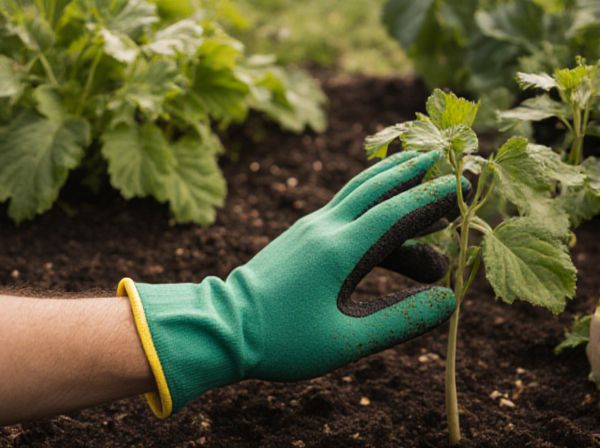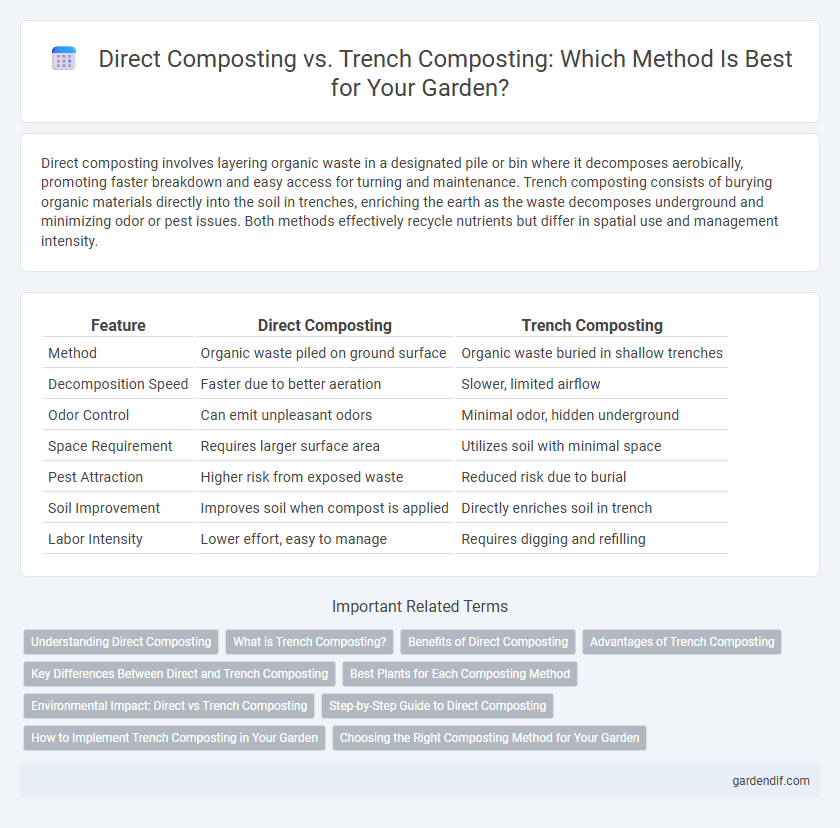
Direct composting vs Trench composting Illustration
Direct composting involves layering organic waste in a designated pile or bin where it decomposes aerobically, promoting faster breakdown and easy access for turning and maintenance. Trench composting consists of burying organic materials directly into the soil in trenches, enriching the earth as the waste decomposes underground and minimizing odor or pest issues. Both methods effectively recycle nutrients but differ in spatial use and management intensity.
Table of Comparison
| Feature | Direct Composting | Trench Composting |
|---|---|---|
| Method | Organic waste piled on ground surface | Organic waste buried in shallow trenches |
| Decomposition Speed | Faster due to better aeration | Slower, limited airflow |
| Odor Control | Can emit unpleasant odors | Minimal odor, hidden underground |
| Space Requirement | Requires larger surface area | Utilizes soil with minimal space |
| Pest Attraction | Higher risk from exposed waste | Reduced risk due to burial |
| Soil Improvement | Improves soil when compost is applied | Directly enriches soil in trench |
| Labor Intensity | Lower effort, easy to manage | Requires digging and refilling |
Understanding Direct Composting
Direct composting involves placing organic waste materials directly onto or into the soil surface, allowing natural decomposition by microbes and earthworms to enrich soil fertility efficiently. It requires minimal effort and no special containers, making it ideal for gardeners seeking sustainable nutrient recycling and improved soil structure. This method accelerates nutrient return to plants, supports soil biodiversity, and reduces waste transport and management costs.
What is Trench Composting?
Trench composting involves burying organic waste directly into a deep trench or hole in the soil, where it decomposes over time and enriches the surrounding earth. This method minimizes surface waste, reduces pests and odors, and accelerates nutrient cycling by promoting microbial activity within the soil profile. Unlike direct composting, trench composting integrates decomposition into the ground, improving soil structure and fertility naturally.
Benefits of Direct Composting
Direct composting accelerates organic matter breakdown by maintaining optimal moisture and aeration at the surface, enriching soil nutrients more rapidly than trench composting. This method reduces labor and soil disturbance while promoting beneficial microbial activity, enhancing plant growth and soil health effectively. Enhanced nutrient availability and faster decomposition make direct composting a sustainable choice for efficient organic waste recycling in gardens and farms.
Advantages of Trench Composting
Trench composting offers superior moisture retention and reduced odor by burying organic waste directly into the soil, promoting faster microbial decomposition. Its method improves soil aeration and nutrient absorption, enhancing plant growth and soil fertility more effectively than surface composting techniques. This technique also minimizes pest attraction and requires less space, making it ideal for small gardens and sustainable waste management.
Key Differences Between Direct and Trench Composting
Direct composting involves layering organic waste on the soil surface allowing natural decomposition, promoting faster nutrient cycling and greater microbial activity. Trench composting consists of burying kitchen scraps and garden waste into a dug trench, minimizing odor and pest issues while enhancing soil structure at the compost site. The key differences lie in application method, decomposition speed, pest control effectiveness, and soil improvement benefits.
Best Plants for Each Composting Method
Direct composting is ideal for nutrient-hungry plants like tomatoes, peppers, and cucumbers, as it allows organic matter to decompose right where the plants grow, enriching the soil directly. Trench composting suits deep-rooted vegetables such as carrots, potatoes, and leeks, providing gradual nutrient release and improving soil structure. Both methods enhance soil fertility but tailoring plant choice maximizes compost benefits and growth outcomes.
Environmental Impact: Direct vs Trench Composting
Direct composting accelerates organic waste decomposition on the soil surface, enhancing microbial activity and reducing methane emissions by maintaining aerobic conditions. Trench composting sequesters carbon deeper into the soil, improving soil structure and moisture retention but may slow aerobic breakdown, potentially increasing localized greenhouse gas release if not managed properly. Both methods contribute to soil fertility, but direct composting offers greater immediate environmental benefits by minimizing nutrient leaching and supporting soil biodiversity.
Step-by-Step Guide to Direct Composting
Direct composting involves layering organic waste such as kitchen scraps and garden clippings directly onto soil, encouraging natural decomposition by soil organisms. Start by selecting a well-drained site, then spread a 3-4 inch layer of brown materials like leaves, followed by green materials, maintaining a balanced carbon-to-nitrogen ratio. Water the pile lightly and monitor moisture levels, turning or mixing occasionally to aerate and speed up composting before the organic matter fully breaks down.
How to Implement Trench Composting in Your Garden
Trench composting involves digging a narrow trench 12-18 inches deep and placing kitchen scraps, garden waste, or organic material directly into the soil before covering it with earth. Implementing this method requires selecting a spot in your garden where the soil is loose and well-drained, then burying compostable material to decompose naturally underground. This approach accelerates nutrient recycling, improves soil structure, and reduces odors compared to direct composting on the surface.
Choosing the Right Composting Method for Your Garden
Direct composting involves layering organic waste materials directly onto garden soil, promoting natural decomposition and enriching the soil with nutrients in place. Trench composting requires digging a narrow trench, filling it with organic matter, and covering it with soil, minimizing pests and odors while improving soil structure over time. Choosing the right method depends on garden size, composting duration, and pest management needs to optimize nutrient recycling and plant health.
Direct composting vs Trench composting Infographic

 gardendif.com
gardendif.com